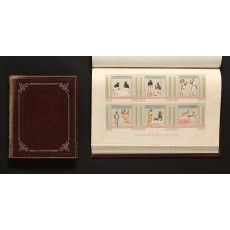 View larger
View larger
Relation d’un voyage dans la Marmarique, la Cyrénaïque, et les oasis d’Audjelah et de Maradèh, accompagnée de cartes géographiques et topographiques, et de planches représentant les monuments de ces contrées
- Subjects
- Archaeology, Ancient Near East & Egyptian
- Islamic art and architecture
- Authors/Creators
- Pacho, Jean Raimond, 1794-1829
- Printers/Publishers
- Didot, Ambroise, Hyacinthe & Frédéric (Librairie de Firmin Didot Frères), active 1827-?
- Didot, Firmin, active 1790-1827
- Other names
- Selenka, Philipp, 1803-1850
Pacho, Jean Raimond
Nice 1794 – 1829 Paris
Relation d’un voyage dans la Marmarique, la Cyrénaïque, et les oasis d’Audjelah et de Maradèh, accompagnée de cartes géographiques et topographiques, et de planches représentant les monuments de ces contrées.
Paris, Librairie de Firmin Didot père et fils, 1827–1828
Two volumes, quarto (280 × 225 mm) and folio (455 × 295 mm):
i: (226) ff. letterpress, signed π4 (half-title; title; dedication; part-title, Premiere Parte) a–d4 a4 (Notice sur la vie et ouvrages de M. Pacho) 1–104 114 (–112–4, cancelled) 12–214 224 (–224, cancelled) 23–514 522 and paginated (8) i–xxxii i–viii 1–404.
ii: 100 numbered plates, of which five are coloured (nos. xlix–li, liii, liv). Plate lxxviii misnumbered lxxix (‘Portant par erreur le no. lxxviii à double’ – Explication des planches, p.383).
Some plates lightly spotted; backs of both volumes sunned.
bound uniformly in polished calf, dyed burgundy, covers decorated with frames in blind and gilt; backs decorated and lettered in gilt; decorated page edges; engraved ticket on white paper Gebunden bei Ph. Selenka in Wiesbaden (in both volumes).
First edition of an account of the author’s exploration of Cyrenaica, accomplished between November 1824 and July 1825. On his return to France, Pacho claimed a prize of 3000 francs sponsored by the Société de Géographie in Paris for an account of that part of ancient Libya. His work was published under the auspices of the Ministère de l’Intérieur, and dedicated to the King. ‘Tragically, suffering from melancholia exacerbated by the conviction that his work had not been recognised for its true merits, he destroyed his personal papers, including drawings and notes on the Cyrenaica, and took his own life on 26th January 1829’.1
A prospectus for the work was circulated in July 1826, projecting fourteen fascicules: four parts of text, imposed in quarto; and ten of plates, in folio, each fascicule priced on papier ordinaire 10 francs and on papier vélin with the engraved plates on papier de Chine 20 francs (‘Après le Ier janvier 1827, les prix seront augmentés d’un tiers’).2 The first fascicules were issued in April 1827;3 one fascicule of text and three of plates had yet to appear when Pacho committed suicide.4 This copy is printed on papier ordinaire, as was the only copy seen in the market in recent times.5 The same plates were coloured in all copies.
Supplementary material includes a list of Arabic place names and a ‘Vocabulaire du Langage des Habitants d’Audjelah’ compiled by Frederick Muller.
Our copy contains the engraved ticket of the bookbinder Philipp Selenka (1803–1850) of Wiesbaden, brother of Johann Jacob Selenka (1801–1871), Hofbuchbinder in Braunschweig.6
references Jean Gay, Bibliographie des ouvrages relatifs à l’Afrique et à l’Arabie (San Remo 1875), p.105 no. 1514; Universal Catalogue of Books on Art (London 1870), p.1520; facsimile edition in the series Études libyennes; no. 1 (Marseille: J. Laffitte, 1979)
1. James C.Thorn, The necropolis of Cyrene: two hundred years of exploration (Rome 2005), p.28.
2. Bibliographie de la France (no. 57, 19 July 1826), p.638 no. 4762.
3. Bibliographie de la France (no. 30, 14 April 1827), p.326 no. 2730: ‘Première partie, Marmarique. In-4° de 15 feuilles ¼, plus une carte. — Idem. Atlas. Ire livraison. In-folio d’une feuille servant de couverture, plus 10 planches […] On promettait une livraison par mois, de telle sorte que l’ouvrage soit entièrement achevé dans le cours de 1827. La souscription était ouverte jusqu’à la fin 1826, et chacune des 14 livraisons coûtera aux souscripteurs… 10 [fr.] Papier vélin 20 [fr]’.
4. The huitième et neuvième livraisons of plates were issued together in April 1829 (Bibliographie de la France, no. 15, 11 April 1829, p.252 no. 2331); the final, dixième livraison appeared two months later (Bibliographie de la France, no. 26, 27 June 1829, p.453 no. 4110). The quatrième partie of text also appeared in June 1829 (ibid., p.450 no. 4072).
5. Sotheby’s, ‘The library of a gentleman: travel and natural history books, many relating to the Near and Middle East’, London, 19 May 1997, lot 201.
6. Two bindings by Philipp Selenka in the Fürstlich Waldecksche Hofbibliothek, Arolsen, are described by Rudolf-Alexander Schütte and Konrad Wiedemann, Einbandkunst vom frühmittelalter bis Jugendstil aus den Bibliotheken in Kassel und Arolsen, Universitätsbibliothek Kassel (Kassel 2002), p.54 no. 68 and Abb. 51 and no. 70. He was a specialist ‘Portefeuillearbeiter’; see Hektor Rössler, Ausführlicher Bericht über die von dem Gewerbverein für das Großherzogthum Hessen im Jahre 1842 veranstaltete Allgemeine deutsche Industrie-Ausstellung zu Mainz (Darmstadt 1843), p.240.



